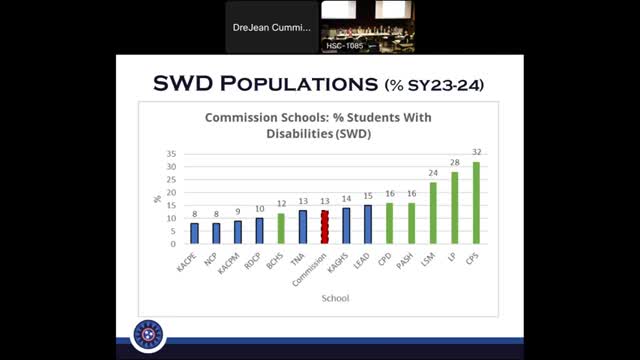Schools Struggle to Support Rising English Learner Population
July 28, 2024 | Tennessee Public Charter School Commission, Deparments in Office of the Governor, Organizations, Executive, Tennessee

This article was created by AI summarizing key points discussed. AI makes mistakes, so for full details and context, please refer to the video of the full meeting. Please report any errors so we can fix them. Report an error »

During a recent government meeting, officials discussed critical issues surrounding special education and English learner (EL) populations in schools, highlighting both challenges and successes in addressing these needs.
One significant point raised was the impact of school size on the percentage of students with disabilities. Cornerstone Prep School, identified as a smaller institution, reported one of the highest rates of students with disabilities. The meeting noted that four out of five schools mentioned were previously part of the Achievement School District, which transitioned to the commission. The commission actively reviews data related to special education to ensure schools are effectively identifying and supporting students with disabilities.
The discussion also revealed concerns about the under-identification of intellectually gifted students, prompting the Tennessee Department of Education (TDOE) to seek ways to enhance support for schools in this area. The meeting emphasized the importance of Individualized Education Programs (IEPs) and the role of school staff and contractors in providing necessary services, including mental health support.
Transitioning to the topic of English learners, officials reported that 26% of students in the commission identify as ELs, one of the highest percentages in the state. Metro Nashville Public Schools has the largest EL population, accounting for a third of the state's total. The meeting highlighted the growing diversity in language representation among students, with over 50 languages spoken in commission schools.
Challenges related to staffing were a focal point, particularly the difficulties schools face in hiring qualified teachers to meet the needs of rapidly increasing EL populations. The meeting noted that schools must comply with new requirements for English language instruction, which has led to significant adjustments in staffing and scheduling.
Additionally, the meeting addressed the implications of the TISA funding model, which bases funding on previous years' enrollment data, creating financial strain for schools experiencing sudden increases in student populations. Officials discussed the potential for utilizing unallocated lottery funds to alleviate some of these burdens, particularly for schools in high-demand areas like Antioch.
The meeting concluded with a review of monitoring and reporting requirements for special populations, emphasizing the need for ongoing compliance with state and federal laws. Despite the challenges, officials expressed optimism about recent successes in monitoring processes and the overall performance of schools in serving students with disabilities and English learners.
One significant point raised was the impact of school size on the percentage of students with disabilities. Cornerstone Prep School, identified as a smaller institution, reported one of the highest rates of students with disabilities. The meeting noted that four out of five schools mentioned were previously part of the Achievement School District, which transitioned to the commission. The commission actively reviews data related to special education to ensure schools are effectively identifying and supporting students with disabilities.
The discussion also revealed concerns about the under-identification of intellectually gifted students, prompting the Tennessee Department of Education (TDOE) to seek ways to enhance support for schools in this area. The meeting emphasized the importance of Individualized Education Programs (IEPs) and the role of school staff and contractors in providing necessary services, including mental health support.
Transitioning to the topic of English learners, officials reported that 26% of students in the commission identify as ELs, one of the highest percentages in the state. Metro Nashville Public Schools has the largest EL population, accounting for a third of the state's total. The meeting highlighted the growing diversity in language representation among students, with over 50 languages spoken in commission schools.
Challenges related to staffing were a focal point, particularly the difficulties schools face in hiring qualified teachers to meet the needs of rapidly increasing EL populations. The meeting noted that schools must comply with new requirements for English language instruction, which has led to significant adjustments in staffing and scheduling.
Additionally, the meeting addressed the implications of the TISA funding model, which bases funding on previous years' enrollment data, creating financial strain for schools experiencing sudden increases in student populations. Officials discussed the potential for utilizing unallocated lottery funds to alleviate some of these burdens, particularly for schools in high-demand areas like Antioch.
The meeting concluded with a review of monitoring and reporting requirements for special populations, emphasizing the need for ongoing compliance with state and federal laws. Despite the challenges, officials expressed optimism about recent successes in monitoring processes and the overall performance of schools in serving students with disabilities and English learners.
View full meeting
This article is based on a recent meeting—watch the full video and explore the complete transcript for deeper insights into the discussion.
View full meeting
